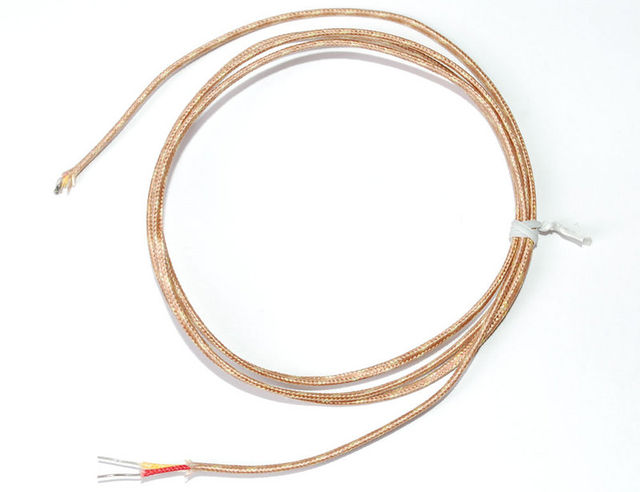Senseur Thermocouple
Introduction
Un thermocouple est une sorte de senseur de température.
Au contraire des senseurs de température à semiconducteur comme le TMP36, le thermocouple n'a aucune électronique à l'intérieur, il s'agit de deux fils de métal fondu ensemble en une petite boule.
Grâce a un effet physique présent entre les deux métal joint, il existe une toute petite tension entre les deux fils. Cette tension issue de l'effet Seebeck (wikipedia) est petite mais mesurable... cette tension s'accroit avec la température.
. The type of metals used affect the voltage range, cost and sensitivity, which is why we have a few different kinds of thermocouples. The main improvement of using a thermocouple over a semiconductor sensor or thermistor is that the temperature range is very much increased. For example, the TMP36 can go from -50 to 150°C, after that the chip itself can be damaged. Common thermocouples on the other hand, can go from -200°C to 1350°C (K type) and there are ones that can go above 2300°C!
Thermocouples are often used in HVAC systems, heaters and boilers, kilns, etc. There are a few different kinds but this tutorial will discuss K type, which are very common and easier to interface with.
One difficulty in using them is that the voltage to be measured is very small, with changes of about 50 uV per °C (a uV is 1/1000000 Volts). While it is possible to read these voltages using a clean power supply and nice op-amps, there are other complications such as a non-linear response (its not always 50uV/°C) and cold-temperature compensation (the effect measured is only a differential and there must be a reference, just as ground is a reference for voltage). For that reason, we suggest only using an interface chip that will do the heavy lifting for you, allow you to easily integrate the sensor without as much pain. In this tutorial we will use a MAX6675 K-thermocouple interface chip which doesn't even require an ADC, spitting out a nice digital data signal of the temperature.
Informations techniques
Voici quelques informations relatives au thermocouple de type-K
- Taille: gauge 24 (épaisseur 2.18mm), longueur 1 mètre (vous pouvez la raccourcir si nécessaire)
- Price: une dizaine d'euro - disponible chez MCHobby.
- Gamme de température: -100°C à 500°C (au delà de cette température, la fibre de verre sera endommagée).
- Tension de sortie: -6 à +20mV
- Précision: +-2°C
- Nécessite un amplificateur tel que le MAX31855
- Interface: MAX6675 (interrompu), ou MAX31855 (numérique), ou AD595 (analogique)
- Fiche technique du Thermocouple Type-K (pdf)
- Fiche technique du MAX31855 (pdf)
Source: Thermocouple
Tutoriel créé par LadyAda pour AdaFruit Industries.
Traduit par Meurisse D. pour MCHobby.be
Traduit avec l'autorisation d'AdaFruit Industries - Translated with the permission from Adafruit Industries - www.adafruit.com
Toute référence, mention ou extrait de cette traduction doit être explicitement accompagné du texte suivant : « Traduction par MCHobby (www.MCHobby.be) - Vente de kit et composants » avec un lien vers la source (donc cette page) et ce quelque soit le média utilisé.
L'utilisation commercial de la traduction (texte) et/ou réalisation, même partielle, pourrait être soumis à redevance. Dans tous les cas de figures, vous devez également obtenir l'accord du(des) détenteur initial des droits. Celui de MC Hobby s'arrêtant au travail de traduction proprement dit.

